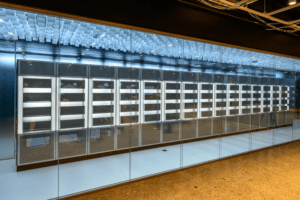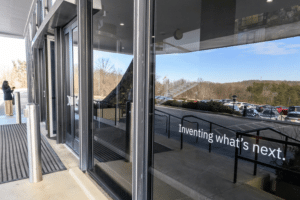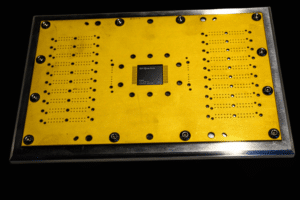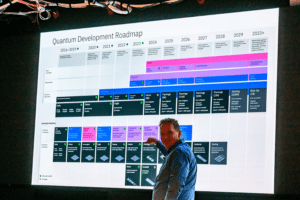The quantum world isn’t just for Antman. At a New York lab, scientists are building a new kind of computer based on the bizarre world of quantum physics.

An analog AI hardware wafer used to produce chips, made by IBM in the United States. (Photo by Enrique Shore)
This article was produced exclusively for News Decoder’s global news service. It is through articles like this that News Decoder strives to provide context to complex global events and issues and teach global awareness through the lens of journalism. Learn how you can incorporate our resources and services into your classroom or educational program.
There is a growing consensus that AI will quickly change almost everything in the world.

The AIU cluster, a collection of computer resources used to develop, test and deploy AI models at the IBM Research Center upstate New York. (Credit: Enrique Shore)
The AI many people already use — such as ChatGPT, Perplexity and now DeepSeek — is based on traditional computers. To process the data analysis needed to answer questions put to these AI programs and to handle the tasks assigned to them takes an enormous amount of energy.
For example, the current energy consumption from OpenAI to handle ChatGPT’s prompts in the United States costs some $139.7 million per year.
Several companies, including Google, Microsoft and the International Business Machines Corp. or IBM, are developing entirely new technologies that can process information faster and more efficiently.
IBM currently manages the largest industrial research organization, with specialized labs located all over the world.
Glimpsing the world’s most powerful computers
The global headquarters of IBM Research are located in the company’s Thomas J. Watson Research Center. Located about one hour north of New York City, it is an impressive building designed in 1961 by Eero Saarinen, an iconic Finnish-American architect who also designed the Dulles International Airport in Washington, D.C., the Swedish Theater in Helsinki and the U.S. Embassy in Oslo.

At the entrance of the IBM research headquarters a simple statement sums up what research scientists are trying to achieve at IBM: “Inventing what’s next.”
At the research center is a “Think Lab” where the company hosts its latest AI and quantum computing hardware as separate systems and showcases them for visitors.
There, Shawn Holiday, a product manager at the lab’s Artificial Intelligence Unit (AIU) said the challenge is scaling the size of semiconductors to not only increase performance but also improve power efficiency.
This new technology is not based on the traditional bits that are the basis of modern binary computers (meaning bits can be either in the state zero or one).

The IBM Quantum System Two, a powerful quantum computer, operating in the IBM Research Center in Yorktown Heights in upstate New York. (Credit: Enrique Shore)
Instead, it uses a quantum processor which can handle more complex algorithms by allowing for a greater variety of operations to be applied within a single computation.
A new way of processing data
The change is much more than a new stage in the evolution of computers. Nanotechnology — the development of devices and systems by manipulating atoms and molecules — has enabled for the first time in history an entirely new branching in computing history. This new technology is exponentially more advanced; it is not just a faster or better version of traditional computers but a totally new way of processing information.

A replica of the IBM Quantum System One, the first quantum computer, on display at the IBM Research Center in Yorktown Heights New York. (Credit: Enrique Shore)
At the quantum level, a basic unit of information can have many more possibilities than just 1 or 0 and because of that, a chip built with this technology could hold massively more processing power than traditional computers.
The current architecture of existing quantum computers require costly, large and complex devices that can refrigerate chips at extremely low temperatures, close to absolute zero (-459º F, or -273ºC) in order to function correctly.
Even though there are some prototypes of desktop quantum computers with limited capabilities that could eventually operate at room temperature, they won’t likely replace traditional computers in the foreseeable future, but rather they will operate jointly with them.
While IBM is focused on having what they call a hybrid, open and flexible cloud, meaning open-source platforms that can interact with many different systems and vendors, it is also pushing its own technological developments in semiconductor research, an area where its goal is to push the absolute limits of transistor scaling.
Scaling down tiny switches
At the lowest level of a chip, you have transistors. You can think of them as switches. Almost like a light switch, they can be off or they can be on. But instead of a mechanical switch, you use a voltage to turn them on and off — when they’re off, they’re at zero and when they’re on, they’re at one.

IBM Heron, a 133-qubit tunable-coupler quantum processor (Credit: Enrique Shore)
This is the basis of all digital computation. What’s driven this industry for the last 60 years is a constant shrinking of the size of transistors to fit more of them on a chip, thereby increasing the processing power of the chip.
IBM produces wafers in partnership with foundry partners like Samsung and a Japanese startup called Rapidus. Consider that the two-nanometer semiconductor chips which Rapidus is aiming to produce are expected to have up to 45% better performance and use 75% less energy compared to seven-nanometer chips on the market in 2022.

Dr. George Tulevski, IBM Research manager of the IBM Think Lab stands next to a world map showing their different labs at the IBM Research Center in Yorktown Heights in New York. (Credit: Enrique Shore)
IBM predicts that there will be about a trillion transistors on a single die by the early 2030s. To understand that consider that Apple’s M4 chip for its latest iPad Pro has 28 billion transistors. (A die is the square of silicon containing an integrated circuit that has been cut out of the wafer).
There may be a physical limit to the shrinking of transistors, but if they can no longer be made smaller, they could be stacked in a way that the density per area goes up.
With each doubling of the trend, there is always a tradeoff of power and performance. Depending on if you tune for power or you tune for performance, with each of these technology nodes, you get either roughly a 50% increase in efficiency or a 50% increase in performance.
A roadmap for advanced technology

Dr. Jay M. Gambetta, IBM’s Vice President in charge of IBM’s overall Quantum initiative. explains the expected quantum development roadmap. (Credit: Enrique Shore)
Dr. Jay Gambetta, IBM’s vice president in charge of IBM’s overall quantum initiative, showed a table that forecasts the processing capabilities increasing from the current 5,000 gates to an estimated 100 million gates by 2029, reaching possibly one billion gates by 2033.
A quantum gate is a basic quantum circuit operating on a small number of qubits. Quantum logic gates are the building blocks of quantum circuits, like classical logic gates are for conventional digital circuits.
With the new more efficient quantum computers, the old assumptions that more capacity requires more power is being revised and will be greatly improved in the near future — otherwise this development would not be sustainable.
A practical example of a current project made possible thanks the advanced technology IBM is developing is Prithvi, a groundbreaking geospatial AI foundation model designed for satellite data by IBM and NASA.
The model supports tracking changes in land use, monitoring disasters and predicting crop yields worldwide. At 600 million parameters, it’s current version 2.0 introduced in December 2024 is already six times bigger than its predecessor, first released in August 2023.
It has practical uses like analyzing the recent fires in California, the floods in Spain and the crops in Africa — just a few examples of how Prithvi can help understand complex current issues at a rate that was simply impossible before.
The impossible isn’t just possible. It is happening now.
CORRECTIONS AND CLARIFICATIONS: After initial publication of this article, IBM pointed out several places in the story where the complex technology it is developing was mis-explained, due to News Decoder’s efforts to translate this difficult-to-understand technology in a way anyone could grasp.
As a result we have reworded some sections and deleted some sentences. In offering the clarifications the company said: “IBM’s quantum computing and AI technologies are based on different architectures. However, the company is exploring the integration of both quantum and classical computing, including AI.”
We would also like to point out two specific corrections: The original post described Google, Microsoft and IBM as private companies. Microsoft and IBM are publicly traded, as is Google’s parent company Alphabet. And Dr. George Tulevski is the IBM Research manager of the IBM Think Lab.
Three questions to consider:
1. How is quantum computing different from traditional computing?
2. What is the benefit of shrinking the size of a transistor?
3. If you had access to a supercomputer, what big problem would you want it to solve?

Enrique Shore is a News Decoder correspondent, photographer and pictures editor with three decades experience covering World Cups, Olympics, presidential elections, summits and the first Gulf War. He was Reuters chief photographer for Argentina, Uruguay and Paraguay, then based in Madrid in charge of the Iberian Peninsula. He later looked after media clients in Spain and Portugal. He is currently an independent photographer, editor and consultant based in New York.
